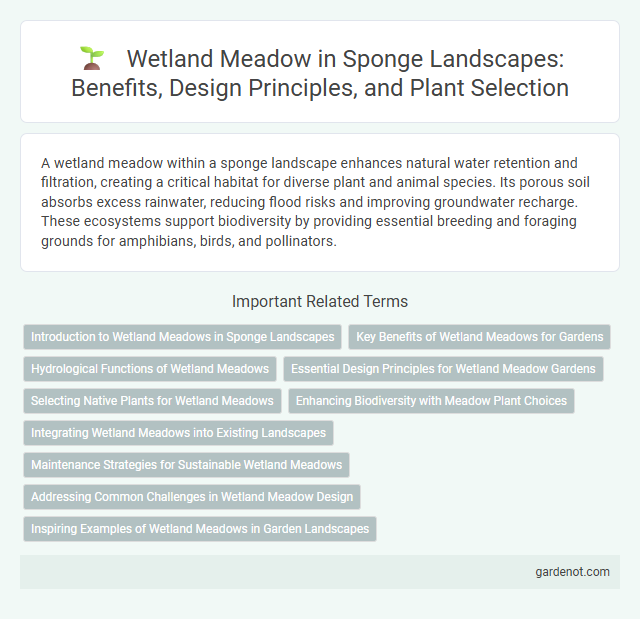A wetland meadow within a sponge landscape enhances natural water retention and filtration, creating a critical habitat for diverse plant and animal species. Its porous soil absorbs excess rainwater, reducing flood risks and improving groundwater recharge. These ecosystems support biodiversity by providing essential breeding and foraging grounds for amphibians, birds, and pollinators.
Introduction to Wetland Meadows in Sponge Landscapes
Wetland meadows in sponge landscapes play a crucial role in enhancing water retention and flood mitigation by absorbing excess rainfall and slowly releasing it into the groundwater system. These ecosystems support diverse vegetation adapted to periodic flooding, contributing to improved soil health and habitat connectivity. Incorporating wetland meadows within sponge landscapes strengthens natural water purification and biodiversity conservation efforts.
Key Benefits of Wetland Meadows for Gardens
Wetland meadows enhance garden biodiversity by providing essential habitats for pollinators, amphibians, and birds. Their natural water retention capabilities reduce soil erosion and improve groundwater recharge, supporting sustainable garden irrigation. These ecosystems filter pollutants and nutrients, promoting healthier plant growth and maintaining water quality in the landscape.
Hydrological Functions of Wetland Meadows
Wetland meadows play a crucial role in regulating water flow by absorbing excess rainfall and slowly releasing it, reducing flood risks and maintaining groundwater levels. Their dense vegetation and soil composition enhance water infiltration and filtration, improving water quality by trapping sediments and pollutants. These hydrological functions support biodiversity and sustain ecosystem services essential for climate resilience and water management.
Essential Design Principles for Wetland Meadow Gardens
Wetland meadow gardens require careful attention to hydrology, soil type, and native plant selection to ensure ecosystem resilience and biodiversity. Incorporating water-absorbing native grasses and wildflowers promotes natural water filtration and habitat support for local wildlife. Strategic contouring and soil amendments optimize water retention and prevent erosion, enhancing the wetland's capacity as a sponge landscape.
Selecting Native Plants for Wetland Meadows
Choosing native plants for wetland meadows fosters biodiversity by supporting local wildlife and maintaining natural hydrology. Species such as Carex stricta (tussock sedge), Asclepias incarnata (swamp milkweed), and Lobelia cardinalis (cardinal flower) thrive in saturated soils and stabilize soil structure. These plants enhance water filtration, reduce erosion, and promote a resilient sponge landscape by mimicking natural wetland functions.
Enhancing Biodiversity with Meadow Plant Choices
Wetland meadows planted with diverse native species such as sedges, rushes, and wildflowers provide essential habitats that support pollinators, amphibians, and bird populations. Selecting species adapted to saturated soils ensures improved water filtration, nutrient cycling, and soil stabilization, thereby enhancing ecosystem resilience. Incorporating a variety of flowering plants extending bloom periods also increases food resources and promotes higher biodiversity throughout the seasons.
Integrating Wetland Meadows into Existing Landscapes
Integrating wetland meadows into existing landscapes enhances biodiversity by providing essential habitats for pollinators and aquatic species, improving water filtration and retention. Designing these meadows with native vegetation supports local ecosystems and mitigates flooding by acting as natural sponges for rainwater. Effective planning incorporates wetland meadows within urban or agricultural areas to restore natural hydrology and promote sustainable land management.
Maintenance Strategies for Sustainable Wetland Meadows
Regular monitoring of hydrology and native vegetation is essential for maintaining wetland meadows, ensuring water levels support biodiversity without causing erosion. Controlled grazing and periodic mowing prevent the encroachment of woody plants and invasive species, promoting native flora and habitat health. Implementing adaptive management plans that respond to environmental changes supports long-term sustainability and ecological balance in wetland meadows.
Addressing Common Challenges in Wetland Meadow Design
Wetland meadow design must prioritize hydrological balance to maintain optimal water retention and prevent seasonal flooding. Native plant selection enhances biodiversity, supports pollinators, and stabilizes soil against erosion. Proper grading and incorporation of natural water flow patterns mitigate standing water issues, ensuring resilient and sustainable wetland ecosystems.
Inspiring Examples of Wetland Meadows in Garden Landscapes
Wetland meadows in garden landscapes showcase vibrant ecosystems supporting diverse native grasses, wildflowers, and amphibian habitats, exemplified by the Audubon Society's Rain Garden and the Cornell Botanic Gardens. These landscapes enhance water retention and filtration, reducing runoff while promoting biodiversity within urban and suburban settings. Incorporating species like sedges, rushes, and native orchids creates resilient, sustainable environments that serve as natural sponges in designed landscapes.
Wetland meadow Infographic

 gardenot.com
gardenot.com